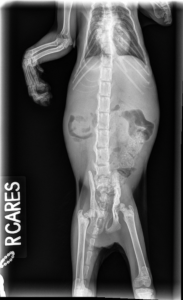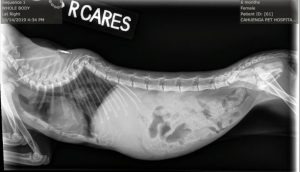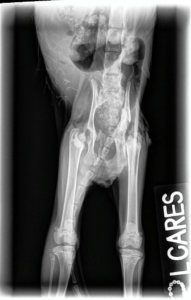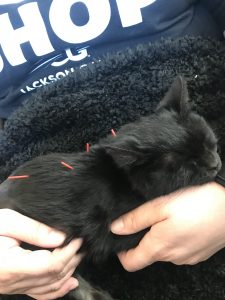Written by a CuraCore Veterinary Medical Acupuncture course graduate. Signed release obtained from client/author. 10S2019008
ABSTRACT:
A 3 month-old Female intact domestic shorthair kitten presented for continued pelvic limb paresis following bilateral femoral head and neck ostectomy surgery performed 10 days prior, despite having multiple photomedicine treatments and physical therapy performed post-operatively in the hospital. The patient was treated with acupuncture on a weekly basis for 4 weeks, gradually regaining more voluntary movement and the ability to ambulate by week 4.
HISTORY OF PRESENT ILLNESS AND CHIEF COMPLAINTS:
Orchid is an estimated 3-month old domestic shorthair kitten, presented for her first acupuncture consultation on 11/01/2019 by a local feral kitten rescue. At the time, she had a bilateral Femoral Head and Neck Ostectomy (FHO) surgical procedure performed at another veterinary hospital about 10 days prior. The rescue had presented Orchid to the hospital as they initially noted some gait abnormalities at her hind limbs and felt swelling around her shoulders. Radiographs revealed both spinal and pelvic limb abnormalities, suspected to be due to a mixture of congenital and traumatic underlying causes (radiograph images attached). Hemivertebrae were discovered running from approximately T5-T9, and attributed to the bony swelling at her interscapular region.
The rescue was informed that the FHO procedure was necessary due to a femoral head fracture on one side, and severe luxation of the femur on the other, which could not be repaired otherwise. The patient was hospitalized at the facility for 7 days following the procedure for continued monitoring and supportive care, after which time, she was discharged back to the rescue and advised on physical therapy routines to perform regularly. While Orchid was recovering in the hospital, in addition to regular nursing care she was given multiple photomedicine (laser therapy) treatments. The details of this treatment regimen are not available, as the hospital has declined requests for medical records.
The rescue reports that Orchid has been eating and drinking normally, is still able to use a very shallow litterbox, however caretakers are concerned that she has still not gained much voluntary movement in her hind limbs.
PHYSICAL EXAMINATION AND CLINICAL ASSESSMENTS:
Initial Physical Exam:
At the time of initial exam, Orchid was still largely non-ambulatory at both pelvic limbs, however would minimally ambulate by dragging herself by her thoracic limbs, when motivated. She otherwise preferred lateral recumbency. She had absent conscious proprioception of her pelvic limbs, with decreased patellar reflexes, and delayed to absent withdrawal reflexes, although she was deep pain positive bilaterally. Crossed extensor reflexes were negative bilaterally. Panniculus reflex was difficult to assess due to patient positioning and appeared painful near sacral segments, but appeared to be within normal limits where tolerated. Perineal reflexes were intact.
On myofascial palpation, she had a significant amount of tension and myofascial restriction in her trapezius muscles bilaterally, as well as trigger points of the triceps muscle groups bilaterally. She had a palpable kyphosis of the affected thoracic vertebral segments and surrounding soft tissue swelling, which complicated palpation of individual vertebral spaces and associated bladder line points of the thorax.



PROBLEM LIST:
Bilateral pelvic limb paresis
Firm interscapular swelling
Pain
DIFFERENTIAL DIAGNOSES:
1. Bilateral Pelvic Limb Paresis:
Vascular – Fibrocartilaginous embolism (FCE), Feline Aortic Thromboembolism (a.k.a. Saddle thrombosis)
Infectious/Inflammatory – Feline Immunodeficiency Virus (terminal phase), Pyogranulomatous inflammation/Granuloma near the spinal cord
Neoplastic – Feline Malignant lymphoma vs. Spinal neoplasm vs. Bone neoplasm
Degenerative – IVDD vs. Degenerative myelopathy
Iatrogenic/Intoxication – Iatrogenic injury peri- or post-operatively
Congenital – Spina bifida vs. Hemivertebrae
Autoimmune – Degenerative myelopathy
Traumatic – Suspected trauma leading to injuries of the femoral head and coxofemoral subluxation, along with subsequent soft tissue damage
Endocrine/Metabolic – Hypocalcemia leading to pathologic fracture of spinal or pelvic structures
Myofascia – Myofascial disturbance secondary to trauma, both pre- and/or post-operatively
1. Firm Interscapular swelling:
Vascular – Hematoma formation
Infectious/Inflammatory – Abscess formation vs. Cellulitis
Neoplastic – Spinal neoplasia vs. Vaccine associated Injection-Site Sarcoma
Degenerative – Intervertebral Degenerative Joint Disease
Iatrogenic/Intoxication – Iatrogenic spinal trauma to thoracic segments leading to vertebral remodeling
Congenital – Hemivertebrae
Autoimmune – Immune Mediated Polyarthritis (IMPA)
Traumatic – Spinal trauma
Endocrine/Metabolic – Hypocalcemia leading to pathologic vertebral fracture
Myofascia – Myofascial disturbance secondary to trauma or congenital anatomical variant
PUTATIVE/DEFINITIVE DIAGNOSES FOR TOP TWO PROBLEMS:
Bilateral pelvic limb paresis, secondary to post-operative pain and myofascial trauma secondary to surgical procedure +/- hemivertebrae
Vertebral malformation, congenital hemivertebrae
MEDICAL DECISION MAKING:
For my medical approach to Orchid, initially I wanted to focus on forelimb strength, as I knew relieving pain and tension here would get her ambulating more initially, while her surgical sites and the associated trauma at her pelvic region continued to heal. As she was a small, young kitten, I was also attempting to use the minimum number of needles necessary while I gauged her response to dry needling, as I did not have a laser therapy device available to me. I also made sure the volunteers were performing her rehabilitation exercises with appropriate technique and frequency.
As she became ambulatory and continued to improve, I wanted to focus on encouraging stimulation and repair of the structures that were most likely affected during her procedure/trauma and the associated surgical approach; namely, the tensor fasciae latae, the gluteal muscles, and the sciatic nerve. I also wanted to offer as much pain relief as possible, while minimizing the number of needles placed in a given session.


MEDICAL ACUPUNCTURE AND RELATED TECHNIQUES USED:
At the time of this report, Orchid has received a series of 4 treatments, at intervals 1 week apart. Primarily dry needling was employed, with occasional manual massage consisting of effleurage, light petrissage, along with occasional acupressure to locations where the patient would not tolerate dry needling.
Needles consisted of coated Seirins, 0.16 gauge and 15mm length were utilized for all sessions due to the patient’s size. Orchid’s physical therapy plan was also supervised at subsequent sessions, advocating for the advancement and modification of her exercises weekly as-needed, based on her progress and repeated exams.
Acupuncture points were selected on the basis of the Medical Acupuncture and Integrative Neuromodulation (MAIN) approach method. Given that this was a feline patient, point selection at each treatment was slightly variable, based on the patient’s presentation and what points were made available at the time. Care was taken in order to maintain a calm, parasympathetic state during treatment. Acupuncture points routinely utilized for dry needling were as follows;
Central Nervous System:
Bai Hui (also an autonomic point), was selected for its effects on lumbosacral pain, pelvic limb pain and neurologic dysfunction. The patient continued to be sensitive on placement of this point at all sessions, despite tolerating most all other locations for dry needling. Acting on T5 and T9 spinal nerves respectively (cranial thoracic spinal nerves), BL 15 and BL 18 (approximated due to pet’s anatomy) were selected for local pain and myofascial restriction relating to the thoracic hemivertebrae segments, as well as compensatory strain and local trigger points at the thoracic limbs post-operatively. GV 4 was utilized stimulating cranial lumbar spinal nerves for pelvic analgesia.
Peripheral Nervous System: Bafeng points stimulating digital nerves were utilized for the first couple sessions, for their documented effects on pelvic limb neuropraxia. BL 40 was utilized as the “Command point” for the lumbar region, with tibial nerve engagement, for it’s effects on pelvic limb pain/paresis, along with BL 60 for similar clinical reasoning, innervation and effects.
Autonomic Nervous System: Also a peripheral point affecting the fibular nerve, ST 36 was utilized for its ability to aid in inflammatory problems generally, as well as for local pelvic limb dysfunction. GV 20 was utilized for it’s calming effects on the patient prior to starting treatments. GV 14 with cervicothoracic spinal nerve input was selected for its effect on neck and back pain, given the patient’s compensatory forelimb pain and myofascial restriction in this area.
Myofascial dysfunction: Local points for shoulder dysfunction/primarily thoracic limb trigger points (variable).
OUTCOMES, INSIGHTS, DISCUSSION, AND REFERENCES:
As a kitten especially, Orchid proved to be very receptive needling in general. Although she did have some points that were persistently sensitive as she healed, this didn’t seem to put her off receiving further needle applications or additional treatments. Now having treated other kitten and adult feline patients, some of which were plegic, the author can appreciate not all felines are accepting of dry needling as a modality. Employing electroacupuncture could have also been helpful in Orchid’s continued treatment as her tolerance for needling improved, although this modality was not available at the time.
It is interesting to note that Orchid received laser therapy at the veterinary hospital multiple times post-operatively for a week after her procedure. It is unfortunate that the details of this treatment protocol have been lost to follow-up/medical record sharing, as the author found it noteworthy that her mobility didn’t appear to improve at all during her first week post-operatively. Perhaps this was employed in a manner to promote incision healing rather than to engage deeper tissues. Consistent with the findings by Wardlaw et al. of improved cosmetic healing of incisions by 7 days post-op, Orchid’s incisions had already healed with visible hair regrowth by the time of her first acupuncture treatment.
In another related study by Liu et al., acupuncture was used successfully to treat chondrodystrophic canines with paraparesis secondary to hemivertebra.
I found it interesting that the surgeon centered on Orchid’s coxofemoral and pelvic injuries as the presumptive cause of her ataxic gait and progressive paraparesis following surgery, when this study showed paraparesis from structurally mild hemivertebra segments alone.
Once Orchid’s radiographs were reviewed in greater detail (only available after having treated her at least once), it was noted that she appeared to have only 11 thoracic vertebrae. This highlighted the importance of a thorough physical and myofascial exam, as possible variations in patient anatomy beyond what is common for the species may alter acupuncture point locations utilized for treatment.
References:
1) Wardlaw JL, Gazzola KM, Wagoner A, et al. Laser Therapy for Incision Healing in 9 Dogs. Frontiers in Veterinary Science. 2019;5. doi:10.3389/fvets.2018.00349
2) Liu CM, Holyoak GR, Lin CT. Acupuncture combined with Chinese herbs for the treatment in hemivertebral French bulldogs with emergent paraparesis. Journal of Traditional and Complementary Medicine. 2016;6(4):409-412. doi:10.1016/j.jtcme.2015.10.004